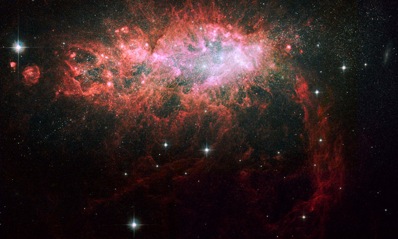Astronomers have solved the mystery as to why a small, nearby, isolated galaxy is pumping out new stars faster than any galaxy in our local neighborhood. It turns out it is actually further away than astronomers first thought.
The discovery happened by accident while Alessandra Aloisi and colleagues from the Space Telescope Science Institute in Baltimore and the European Space Agency were using Hubble to search galaxy NGC 1569 for red giant stars. Red giants can be used to estimate a galaxy's age since they are reliable ‘standard candles’ for measuring distance because they all shine at the same brightness.
"When we found no obvious trace of them, we suspected that the galaxy was farther away than originally believed," says Aaron Grocholski. "We could only see the brightest red giant stars, but we were able to use these stars to re-calibrate the galaxy's distance."

NGC 1569's core is made up of three giant star clusters, each containing more than a million stars. New analysis place the galaxy at a distance of 11 million light years from Earth. Image: NASA/ESA/STScI/AURA/Hubble Heritage Team/A.Aloisi.
Previous estimates of the galaxy's distance were made with ground-based telescopes and were unreliable because they looked at the galaxy's crowded core and were unable to resolve individual red giant stars. Hubble was able to resolve both the galaxy's cluttered core and its sparsely populated outer fringes, identifying individual red giants, and therefore allowing a precise distance to the galaxy to be determined.
"This was a serendipitous discovery," says Aloisi. "Hubble didn't go deep enough to see the faintest red giant stars we were hunting for because the galaxy is farther away than we thought. However, by capturing the entire population of the brightest red giant stars, we were able to calculate a precise distance to NGC 1569 and resolve the puzzle about the galaxy's extreme starburst activity."
The new observations reveal that it is located around one and a half times farther away than astronomers previously thought, at a distance of nearly 11 million light years. The extra distance places the galaxy in the middle of a group of about 10 galaxies centred on the spiral galaxy IC 342. Gravitational interactions among the group's galaxies may be compressing gas in NGC 1569 and igniting the frenetic bout of star formation, which is over 100 times higher than star formation in the Milky Way.
"Now the starburst activity seen in NGC 1569 makes sense, because the galaxy is probably interacting with other galaxies in the group," says Aloisi. "Those interactions are probably fueling the star birth."
This type of starburst galaxy is thought to drive the evolution of galaxies in the distant and young Universe. "Starburst galaxies can only be studied in detail in the nearby Universe, where they are much rarer,” says Roeland van der Marel. “Hubble observations of our galactic neighborhood, including this study, are helping astronomers put together a complete picture of the galaxies in our local Universe. Put the puzzle pieces in the right place, as for NGC 1569, and the picture makes much more sense."
The results are published in the 20th October issue of the journal Astrophysical Journal Letters.
from:http://astronomynow.com/081121Hubbleresolvesmysteryoflonestarburstgalaxy.html





 RSS Feed (xml)
RSS Feed (xml)